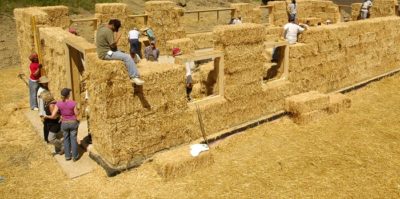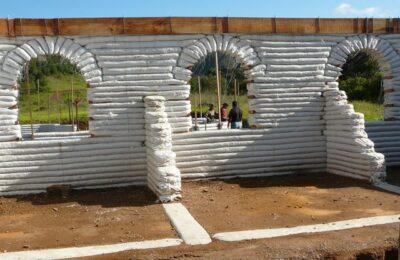There is nothing quite as exciting as purchasing bare acreage with plans to turn it into a working homestead.
But building a traditional home, even one considered to be small by most standards – say, a 2 bedroom, 1 bath — is extremely expensive. Many people go this route not realizing that there are alternative ways of building a home that can save you money — and even lower house maintenance costs over time.
Here are three inexpensive housing materials that you can use for off-grid and other self-sufficient homes.
1. Straw Bales
Straw is a common building material in some parts of the world. Whole bales are actually a great inexpensive housing material for creating solid, well-insulated walls. You then can add a thatched roof or go with something more traditional like metal.
Pocket sized solar generator provides dependable backup power.
Building with straw bales is ridiculously easy, as they can be used just like bricks. Usually these bales are light enough in weight that one person can move them, although two people is a better idea. They are safer to work with when it comes to climbing up a ladder to stack as well. Due to the thickness and density of good bales, they are great for keeping heat and cold out — thereby lowering energy costs. Ironically, straw bale construction is more fire resistant than traditional building materials, again, due to the density.
Straw bale construction is best for very dry climates, and constant high humidity can cause structural issues. You must perform construction during warm, dry weather. You do not want any moisture getting into the bales while building. Naturally, you also need to be certain that the bales you use have been properly dried.
2. Cob
There is nothing quite as picturesque and quaint as a cob cottage nestled into the countryside. Cob is one alternative building material that uses some straw, as alluded to above, along with earth and sand to create a moldable clay-like blend. Adobe is essentially the same thing as cob. Instead, the mixture is formed into bricks and dried in the sun before being used.
Cob and adobe are both very strong building materials. They are also fairly versatile in terms of where they can be used. You can tell by the popularity of this clay-like mix in wet areas of the UK to hot, dry climates in Africa. Cob is more structurally sound, too. Both are particularly suited for regions that experience a lot of inclement weather and earthquakes.
A downside of working with cob is that it can be quite labor- and time-intensive. Cob structures will also need time to properly cure and dry. Adobe is quicker to work with after the bricks have been dried. A very good mix of natural building materials would be straw bale exterior walls and cob/adobe interior walls.
Low Cost, Portable, Emergency Backup Power, Solar Generator
3. Earth Bags
Sometimes called sand bags, are another way to build a solid, off-grid home. They are not as popular as some other natural building materials but are worth exploring. Using earth bags is similar to cob in the sense that you don’t really need special skills or tools. You’re essentially filling bags with earth or sand, stacking them like bricks to form your walls and tamping them down.
Earth-bag buildings are resistant to fires and to many natural disasters like flooding, hurricanes and earthquakes. Due to the density and materials filling the bags, rodents will not be a concern, which is a worry some people have about straw bale buildings. For the most moisture resistant building, use polypropylene bags, but you can really use any type of recycled bag for building, which naturally helps reduce waste.
Since bags are being used, the structure won’t be totally biodegradable. There is a lot of labor involved when using earth bags. Moving buckets of earth, filling bags and especially stacking can be very tiring. You will definitely want the help of a team of people if you plan to get the building done in a timely fashion.
In Conclusion
These three building alternatives are just the tip of the iceberg in terms of what inexpensive materials are out there for building. There are a ton of resources on the Internet about using natural or alternatives materials for building homes. Homes made from natural or recycled materials have a lot of character, and when built well will outlast pretty much any traditionally built home. They offer far superior insulation and less negative impact on the environment. Using natural materials also eliminates the dangers of toxins that are so prevalent in traditional building materials.
Do you have experience building homes with alternative materials or have plans to do so? Please share your stories and any ideas for inexpensive housing materials in the comment section below.
 Off The Grid News Better Ideas For Off The Grid Living
Off The Grid News Better Ideas For Off The Grid Living





